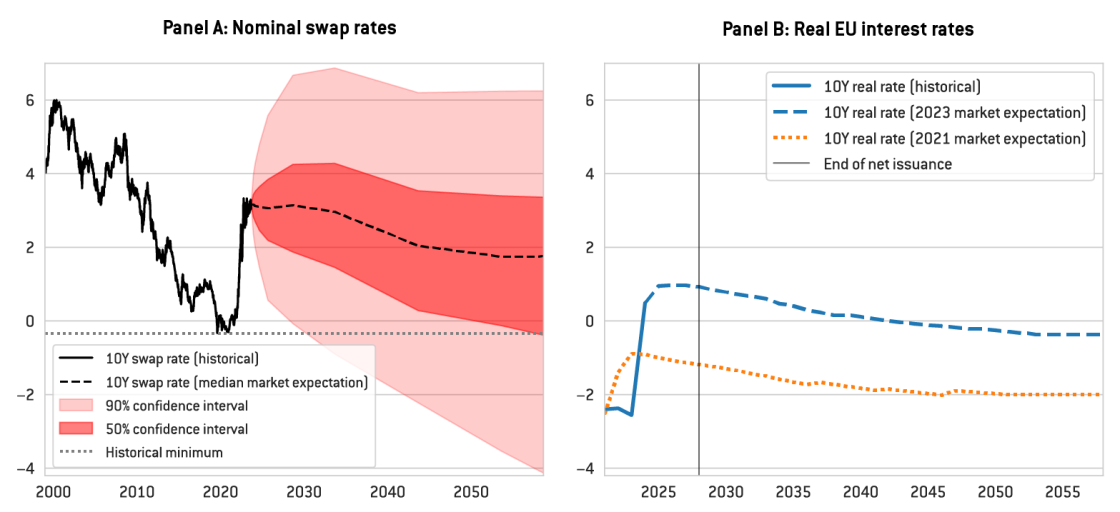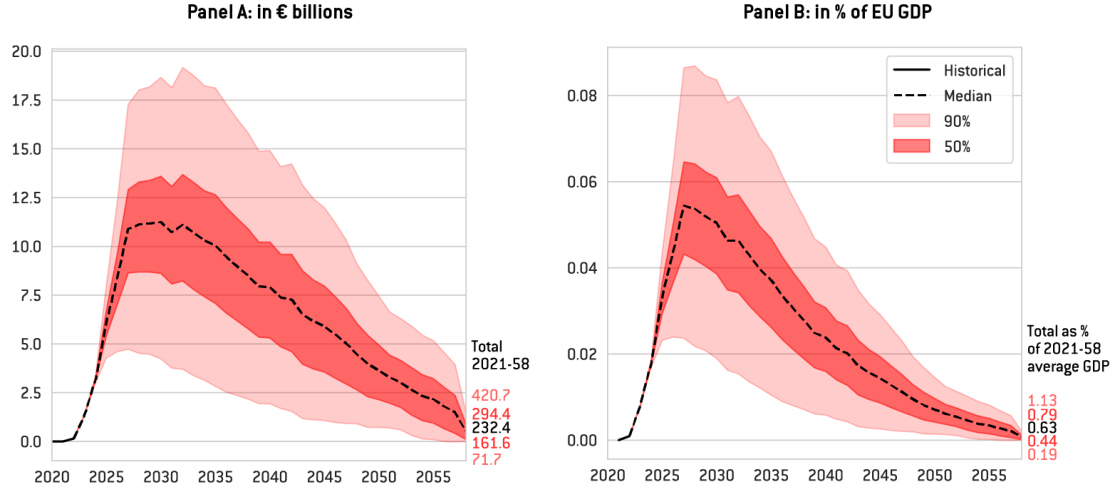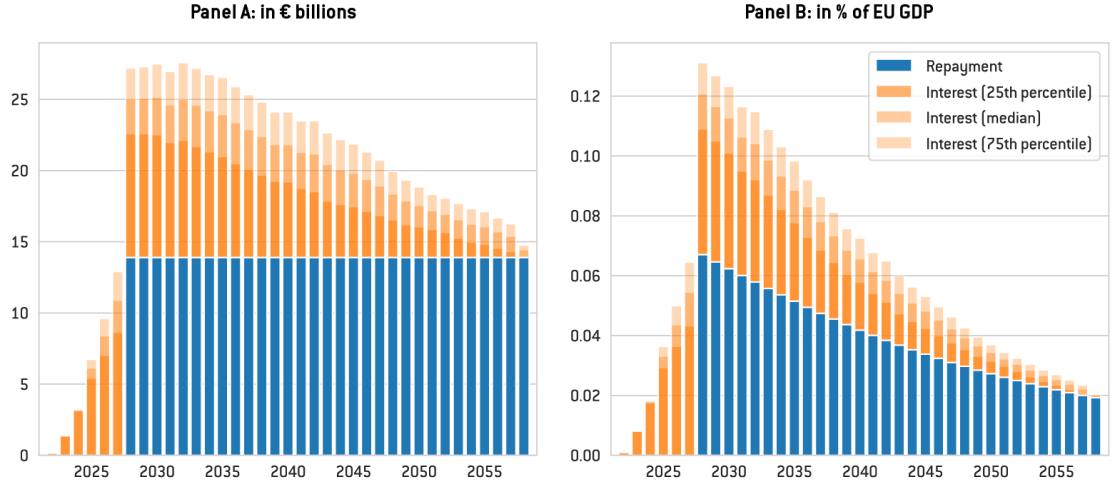As part of its NextGenerationEU (NGEU) post-COVID-19 recovery and economic greening plan, the European Union intends to borrow about €421 billion (in current prices) before the end of 2026 to fund “non-repayable support” to EU countries. This debt and the interest on it must be repaid before 2058 from the EU budget. Here, we estimate what these costs could amount to 1 .
The costs will depend mainly on the future trajectory of interest rates paid by the EU. Predicting interest rates for such a long time horizon is challenging but market expectations (based on interest rate swaps) provide a good baseline. For instance, market expectations are that 10-year rates will remain relatively stable until 2030, before slowly falling and stabilising at a lower level in the long run. Investors anticipate the 10-year euro swap rate, which closely mirrors EU yields (with a small spread, typically around 10 basis points on 10-year rates), declining towards 1.8 percent by 2058 (Figure 1, Panel A).
The uncertainty surrounding this expectation can be gauged by analysing the expected volatility of future interest rates. Probabilities that market participants attach to different future interest rate trajectories can be derived from swap-options. This exercise indicates considerable uncertainty about the future path of nominal euro rates. There is a 50 percent probability that rates will fall within the range of -0.4 percent to 3.4 percent in 2058, while the 90 percent confidence interval ranges from -4.1 percent to 6.2 percent (Figure 1, Panel A).
While the median trajectory for nominal rates represents a substantial increase compared to prevailing market expectations at the start of the borrowing programme in 2021, it is useful to also consider the change in real terms. Figure 1 Panel B compares 2021 and current market expectations for the 10-year real interest rate on EU debt. In 2021, these expectations were negative for the entire period of the programme, making EU borrowing profitable in real terms. But since 2021, these expectations have moved up, resulting in a real rate of 0.92 percent in 2028, when new net issuance will end, before returning to negative levels after 2043. Thus, the real cost of EU debt is no longer expected to be negative, but the low average real rates indicate much lower interest costs than nominal rates might suggest.
Figure 1: 10-year euro swap rates, real interest rates, and market expectations (in %)

Source: Bruegel based on Danske Bank and Bloomberg. Notes: Panel A shows historical and possible future values of the 10-year euro swap rate, which reflects market expectations of the average short-term rate over the next 10 years and can thus be considered a good proxy for the 10-year EU yields. Dark and light red shaded areas correspond to the 50 percent and 90 percent confidence intervals, respectively, as defined by risk-neutral probabilities derived from the option prices on 10-year-swap rates. Panel B shows historical and expected real interest rates for 10-year EU debt, based on 10-year euro swaps corrected for the average swap-EU yield spread and market inflation expectations.
Annual costs up to 2058
To project the interest charges that will have to be paid from the EU budget, we combined these interest rate expectations and their volatility with information on the EU stock of debt, projections for future funding needs, the current distribution of debt maturities and spreads between swap rates and EU bond yields (see the annex for details). However, we judge the probability of extreme negative rates (anticipated by the market and resulting from the methodological assumptions of the pricing model) to be exaggerated, and thus we assume that future European rates cannot drop below their historical minimum, ie that 10-year swap rates will not go below their 2020 level of minus 0.33 percent (dashed grey line in Figure 1, Panel A) 2 .
Our results show that yearly interest costs could increase to €10.8 billion in 2030 in the baseline trajectory (ie 0.05 percent of expected EU GDP), before decreasing gradually up to 2058. Total interest costs up to 2058 could amount to around €222 billion (ie 0.6 percent of the expected 2021-58 average of EU GDP; see bold numbers in Figure 2). Because of the significant uncertainty about future interest rates, interest costs may vary substantially around baseline estimates. With a 50 percent probability, interest costs could fall within the €8.2 billion to €13.2 billion range in 2030, while the 90 percent confidence interval ranges from €3.9 billion to €
Figure 2: Projected annual and total interest costs borne by the EU

Source: Bruegel based on Danske Bank, Bloomberg and European Commission. Notes: Panel A presents historical and projected annual interest rate costs (lines, LHS) and total costs in 2021-2058 (numbers in bold, RHS) borne by the EU, in current prices. Fifty percent and 90 percent confidence intervals are based on option implied interest rate volatilities (see the annex). Panel B presents the same costs over projected nominal EU GDP, and the estimated share of total costs in 2021-2058 in average annual EU GDP (numbers in bold, RHS).
Starting in 2028, when a new budget cycle begins, the EU budget will also need to include provisions for the repayment of the EU debt, in addition to interest costs. However, the debt issued between 2021 and 2026 will not necessarily need to be reimbursed immediately when it matures, as the legislation allows for some rollover after 2027, to enable a smooth decline in EU debt.
In our simulations, from 2028, we thus assume some rollover to ensure a linear decline in the total debt stock until 2058. From this, we estimate that the annual principal repayments will be around €13.9 billion from 2028 to 2058. Starting in 2028, the EU will thus be required to allocate significantly more money to service its debts. At the 50 percent confidence interval, the total annual financial needs could reach between €22 billion and €27 billion in 2030 (respectively 0.11 percent and 0.13 percent of EU GDP), before declining gradually towards €13.9 billion at the end of the programme. In total, for NGEU non-repayable support to EU countries, between about €582 billion and €715 billion will likely be spent to pay interest and to reimburse the debt (Figure 3, Panels A and B).
However, these amounts, reaching a maximum of 0.15% of GDP for the trajectory at the 95th percentile, would be much lower than a 0.6 percent of GNI temporary increase, decided in 2020, in the amounts the EU can call on from EU countries if needed. This would ensure there is no risk of the EU defaulting on its financial commitments.
Figure 3: Projected annual repayments and interest costs borne by the EU

Source: Bruegel based on Danske Bank, Bloomberg and European Commission. Notes: The charts show historical and projected annual interest rate costs (orange) and principal repayments (blue) borne by the EU budget in € billions and in percent of GDP. Percentile estimates are based on option implied interest rate volatilities (see the annex).
Will the EU have sufficient revenues?
In June 2023, the European Commission (2023a) proposed a package of ‘own resources’, or revenues for the EU budget. Under the proposal an estimated €36.5 billion (in 2018 prices) per year would be raised for the EU budget between 2028 and 2030: €19 billion from the EU emissions trading system, €1.5 billion from the carbon border adjustment mechanism (CBAM)3 and €16 billion from a new statistics-based own resource on company profits. Adjusting for inflation4, this new package would in principle raise approximately €50 billion annually between 2028 and 2030. Given the scarcity of forecasts on carbon prices, carbon emissions, ETS and CBAM coverage, and the current lack of details on the revenues that could be derived from a corporate profits levy, estimating revenues after 2030 is a challenge beyond the scope of this analysis.
However, €50 billion annually could, in theory, be enough to cover the costs associated with NGEU borrowing: our analysis suggests that these costs could peak at €27 billion in 2030 for the 75th percentile trajectory, or €32 billion for the 95th percentile trajectory. This assumes, however, that the Commission’s estimates are realistic and its proposals are approved unchanged. This is unlikely5. Moreover, there are other calls on ETS revenues (social and innovation funding), which should reduce substantially the amount that could be used to service NGEU debt.
Given that the costs associated with EU borrowing will peak as soon as 2028-2030, it is crucial that a sufficient package of own resources is in place by then. Otherwise, countries must either reduce other EU budget expenditures6, or increase their national contributions, through a call on the 0.6 percent of GNI guarantee set up in 2020.
References
Claeys, G. C. McCaffrey and L. Welslau (2023a) ‘The rising cost of European Union borrowing and what to do about it’, Policy Brief 12/2023, Bruegel, available at https://www.bruegel.org/policy-brief/rising-cost-european-union-borrowing-and-what-do-about-it
Claeys, G., C. McCaffrey and L. Welslau (2023b) ‘An estimate of the European Union’s long-term borrowing cost bill’, briefing for the European Parliament Budget Committee, available at https://www.europarl.europa.eu/RegData/etudes/BRIE/2023/754286/IPOL_BRI(2023)754286_EN.pdf
Claeys, G., M. Demertzis and F. Papadia (2019) ‘Challenges ahead for the European Central Bank: Navigating in the Dark’, analysis for the European Parliament Economic and Monetary Affairs Committee, available at https://www.europarl.europa.eu/thinktank/en/document/IPOL_IDA(2019)638419
European Commission (2021) ‘Semi-annual report on the execution of the NextGenerationEU funding operations pursuant to Article 12 of Commission Implementing Decision’, Report C(2021)2502, available at https://commission.europa.eu/system/files/2022-02/com_2022_43_1_en_act_part1_v6.pdf
European Commission (2022) ‘Half-yearly report on the implementation of borrowing, debt management and related lending operations pursuant to Article 12 of Commission Implementing Decision’, Report C(2022)9700, available at https://commission.europa.eu/system/files/2023-02/COM_2023_93_F1_REPORT_FROM_COMMISSION_EN.PDF
European Commission (2023a) ‘An adjusted package for the next generation of own resources’, Communication 2023/330, available at https://commission.europa.eu/system/files/2023-06/COM_2023_330_1_EN_ACT_part1_v5.pdf
European Commission (2023b) ‘Funding Plan July-December 2023’, Factsheet, available at https://commission.europa.eu/system/files/2023-07/Factsheet_Funding%20Plan_July-December%202023_modified_10.07.pdf
European Commission (2023c) ‘Report from the Commission to the European Parliament and the Council- Half-yearly report on the implementation of borrowing, debt management and related lending operations pursuant to Article 12 of Commission Implementing Decision C(2022)9700’, Report 2023/461, available at https://eur-lex.europa.eu/legal-content/EN/TXT/?uri=COM%3A2023%3A461%3AFIN&qid=1690541270364
European Commission (2023d) ‘Half-yearly report on the implementation of borrowing, debt management and related lending operations pursuant to Article 12 of Commission Implementing Decision’, Report C(2023)93, available at https://commission.europa.eu/system/files/2023-02/COM_2023_93_F1_REPORT_FROM_COMMISSION_EN.PDF
European Commission (2023e) ‘Communication on the mid-term revision of the Multiannual Financial Framework 2021 – 2027’, COM(2023) 336 final, 20 June 2023, available at: https://commission.europa.eu/system/files/2023-06/COM_2023_336_1_EN_ACT_part1_v4.pdf

